The Loss and Recovery of the Anchors from Matthew Flinders’ Ship HMS Investigator
by Steve Reynolds
The large anchor inside the South Australian Maritime Museum is from Matthew Flinders’ ship HMS Investigator. It is a 4m-long, 1 tonne stocked anchor and it is possibly the oldest known anchor in South Australia. It has a (replica) large wooden stock.
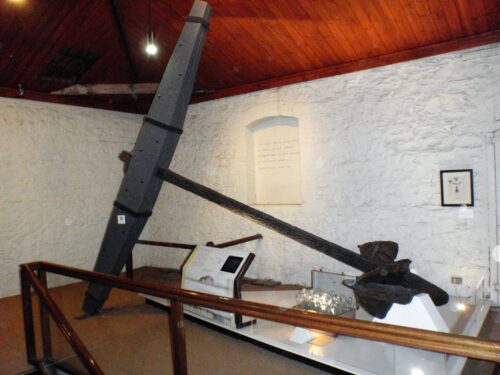
(Photo taken by Steve Reynolds)
It was the ‘best bower’ anchor from HMS Investigator, the largest of two (possibly 3) anchors that were cut loose by Matthew Flinders during rising winds in 1803. It was located in Goose Island Bay at Middle Island, WA on 14th January 1973 by members of the Underwater Explorers Club of SA.
Two anchors were both raised up by the lighthouse ship Cape Don on 19th January 1973. Video footage in the museum shows the two anchors being recovered. They have now been preserved and restored. The smaller anchor, a 3m-long, 406kg stream anchor, was placed in Canberra along with an anchor from James Cook’s Endeavour.
According to “Ill-Starred Captains – Flinders and Baudin” by Anthony J Brown, the loss of the anchor occurred during Matthew Flinders’ circumnavigation of Australia in HMS Investigator. The ship was returning to Port Jackson (Sydney Cove) from Timor in 1803. Having reached the southern coast of Australia, and sailing east of Esperance, she headed for the Recherche Archipelago.
Some of her crew were sick and dying at this point. Several of them had gone from good to bad health quickly. This led to barely having enough crew to sail the ship. On 17th May 1803, the Investigator anchored in Middle Island’s Goose Island Bay. The bay is named after an island in the bay.
(Middle Island is the largest island in the Recherche Archipelago. It is located mid-way in the archipelago. It seems that it may have formerly been known as Manduran Island. The archipelago and many of its islands were named by Rear-Admiral Bruni d’Entrecasteaux when he was searching for missing explorer Jean-Francois de La Perouse in 1792. D’Entrecasteaux’s vessels were the Recherche and the Esperance. Esperance and the Recherche Archipelago were named after these two ships.There are said to be some 105 islands, 1500 islets and many barely submerged rocks that make up the complete archipelago.)
The ship’s boatswain (bosun), Chas Douglas (or Douglass), died that day (17th May) and was buried on land (Middle Island or Goose Island?) An engraved copper plate was placed at his grave. The quartermaster, William Hillier* also died on the 21st May whilst the ship was still anchored in Goose Island Bay. It was about this time that the remaining crew attempted to up anchor. Their anchors were not holding in rising winds.
* (In my article titled “The Recovery of Two of HMS Investigator’s Anchors”, MLSSA Newsletter, September 2004, I wrote, “Middle Island is the largest island in the (Recherche) archipelago. Flinders had climbed Middle Island’s 165m-high peak to its summit on 15th February 1802 to survey the surrounding waters. It is now called “Flinders Peak”. It overlooks the spectacular pink lake called Lake Hillier. The lake is saturated with salt, and John Thistle collected some for the Investigator. John Thistle was the master on the Investigator. . . . . At http://www.nma.gov.au/audio/transcripts/landmarks/NMA_Flinders_Recherche_20100421.html I found “From 15 to 17 January 1802, the Investigator spent three days at Middle Island where the scientific gentlemen collected, drew and painted the flora, and shot and collected and also depicted fauna specimens. At the pink lake, the pink colour of the water and supplies of salt excited attention.” and then it reads: “There was another death and more bad luck. John Hillier, quartermaster, died as Investigator was leaving. Flinders also reported difficulty leaving Middle Island”. So, it seems that the lake was named after the quartermaster of the Investigator, John Hillier.)
In “The Skindiver’s Underwater World” by Graeme R Dodd, Doug Seton related Matthew Flinders’ own account of the loss of the anchors: –
“At daylight of the 21st (May 1803) having a fresh breeze at NW, we prepared to depart and hove short; but the ship, driving before the sails were loosed and there being little room astern, a second bower was dropped and a kedge anchor carried out. This last not holding after the bowers were weighed, a stream anchor was let go, and before the ship brought up it was again necessary to drop the best bower. At this time we were not more than a cables length (600 feet) from the rocks of Middle Island; and the ship being exposed to great danger with the least increase of wind, we got a spring on the stream cable and began to heave on the best bower. In the meantime the ship drove with both anchors ahead, which obliged me on the instant, to cut both cables, heave upon the spring and run up the jib and staysails; and my orders being obeyed with an alacrity not to be exceeded we happily cleared the rocks by a few fathoms and at noon made sail to the Eastward.”
The vessel’s small bower anchor (from the port bow) took some time to raise, and the ship drifted in a strong breeze. The best bower anchor (from the starboard bow) had to be let go. A kedge anchor was eventually run out in an attempt to hove upon the best bower anchor. The vessel kept drifting towards the shore and the stream anchor and small bower anchor had to be let go. The crew managed to make sail and get clear of the surf on the shore (having lost the best bower anchor, stream anchor and small bower anchor?). The Investigator arrived in Port Jackson (Sydney Cove) on 9th June 1803.
(A bower anchor is each of two anchors carried at a ship’s bow. The best bower anchor is the starboard bower anchor, whilst the port bow anchor is called the small bower anchor. The stream anchor is a secondary anchor used in working a vessel up or down a river. It was similar to the bower anchor but smaller. They were also used to moor a vessel in a channel. They were commonly fitted with hemp cables. Hemp was employed in preference to chain since the anchor was often carried out astern by boat and chain.)
In 1972, Doug Seton, an information officer with the South Australian Museum, planned an expedition to Middle Island to recover the (two?) lost anchors. According to “Let’s Go For a Dive – 50 years of the Underwater Explorers Club of SA” edited by Peter Christopher and Nicolas Cundell, Doug Seton felt that he had enough information to locate the anchor(s?).
He had read Flinders’ own account and any other literature pertaining to the Investigator’s voyage. He spent many years painstakingly researching the topic in archives and museums, and talking with maritime historian, Bob Sexton.
Doug then headed an expedition in December 1972, comprising of other members of the UEC of SA – Terry Drew, Helen Drew, Peter Koch, Rosalie Koch and John Summers. They set forth from Adelaide on 27th December (a Wednesday). It would be a long road trip to WA by cars towing boats “and enough equipment to maintain an underwater search for several weeks”. A bad accident just 22kms north of Port Wakefield, however, saw the group return back to Adelaide.
“The Skindiver’s Underwater World” by Graeme R Dodd gives details of the accident. Two of the group were hospitalised, and one car and boat were damaged. The group managed to re-start the expedition in January 1973. They had to drive to the Cape Arid National Park in WA, and then travel by boats in Arid Strait out to Middle Island in the Recherche Archipelago. The track through the National Park was “terrible” and the journey along the beach was “treacherous”. They got bogged on the beach several times.
Their small boats were then used to ferry the equipment out to Middle Island. One of the boats was swamped on one of the ferrying trips, causing damage to valuable equipment. The group made good use of an iron shack that they found had been left on the island. It had been built by a fishing group in 1952.
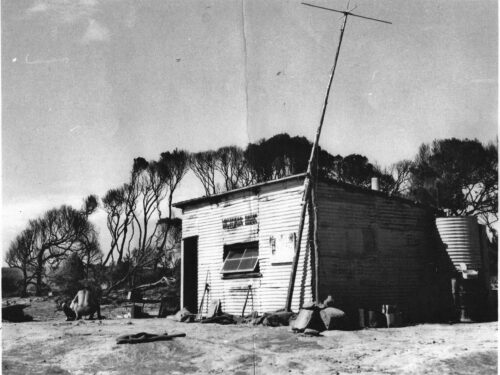
The iron shack on Middle Island
(Photo courtesy of Doug Seton)
The winds were so strong for the first week that no boats could be launched to begin searching for the anchors. This did give them some time, however, to prepare for the search, which began on 11th January.
The 4m best bower anchor was missed by about 30 metres on the first attempt, which involved towing a diver behind a boat on an underwater sled called a manta board. It was, however, found three days later, on 14th January. A further search nearby located the 3m-long stream anchor.
A lighthouse tender vessel called the CLS Cape Don was soon on hand to assist in recovering the two anchors. They were both hoisted aboard the Cape Don on 19th January, almost 170 years after being cut loose by Flinders.
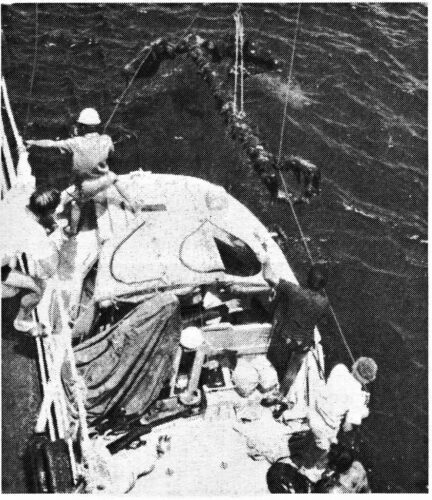
(Photo from “The Skindiver’s Underwater World” by Graeme R Dodd”)
The Cape Don took the two anchors to Fremantle, WA where they were to be preserved for display.
Doug Seton wrote a letter of thanks to the State of WA. It was published in The West Australian newspaper on 2nd February 1973, along with this photo of the large anchor being raised: –
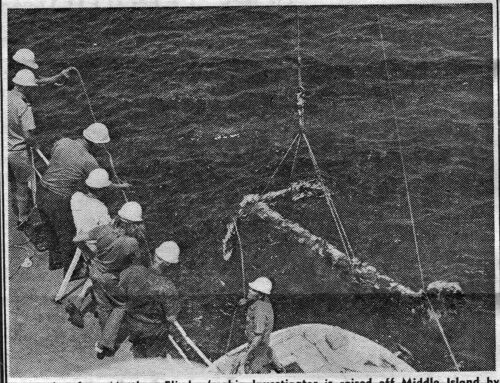
Doug’s letter to the paper is reproduced below as it gives further insight into the expedition: –
“On behalf of our expedition, I wish to express appreciation to many West Australians who assisted our venture.
We are grateful to Mr Don McKenzie, of Esperance, who aided us with an outboard motor, and who also introduced Mr Don Gulvan, who provided a truck and driver to take us to Cape Arid with our equipment.
Thanks go also to Mr Tony Moore, whose two-way radio and other contributions played an important part in the success of the expedition.
Others who helped included Mrs Crocker, sen., of Balladonia Station, and D. Spittle, D. Priestly, Q. Landra and D. Barratt.
I met Bob Fernie, of Kalgoorlie, in Esperance, to thank him for the use of the shack on Middle Island built by his fishing crew in 1952.
We also wish to thank the Fisheries and Fauna Department for permission to camp on Middle Island and the National Parks Board, which allowed us to launch our boats from Cape Arid national park.
The WA Museum was told of the expedition in advance, and arrangements were made for the anchors to be protected after recovery.
Our expedition is grateful to the postmaster and staff at Esperance and to the ABC in Perth.
Captain J. Marion and the crew of the CLS Cape Don made a fine job of the actual recovery programme. Their care and attention in raising the anchors and their efforts to ensure that the anchors would not deteriorate during the voyage to Fremantle, were appreciated.
It will probably be some time before the anchors are fully preserved, but I was pleased to know that the necessary treatment will be carried out by Dr Colin Pearson, who restored Captain Cook’s cannon.
While on Middle Island, expedition members conducted an environmental clean-up programme, removing rusty tins, broken beer bottles and other rubbish left behind over many years, and burying it in deep pits.
We removed the rubbish from the old sealer’s well, and repaired the stonework on top to prevent native animals from falling down the well. We left a big supply of non-perishable food in the shack for the use of anyone who visits the island.
Our expedition has offered the underwater-glider, built from driftwood on Middle Island, to the Esperance Historical Society.
Even if our expedition was conceived in South Australia (where Matthew Flinders is rightly regarded as that State’s first explorer), it is obvious that we were aided all the way by the people of WA, with the knowledge of the authorities directly concerned.
We hope that if our own claim is successful, the “powers that be” will see fit to return Flinders’ stream anchor to Esperance, recognising in perpetuity the help which the people in WA gave us.”
A four-way fight for the rights to the anchors was fought by the SA & WA Governments and the British and Australian Governments. The Advertiser of 14th April reported that SA would get the preserved and restored best bower anchor. The stream anchor was placed along with an anchor from James Cook’s Endeavour in Canberra.
(My thanks go to Doug Seton for providing me with much of the detail reported above.)
REFERENCES:
“Ill-Starred Captains – Flinders and Baudin” by Anthony J Brown
“Let’s Go for a Dive – 50 years of the Underwater Explorers Club of SA” edited by Peter Christopher and Nicolas Cundell
“The Skindiver’s Underwater World” by Graeme R Dodd
“A Hundred Islands in a Lonely Sea” by Howard Whelan, Australian Geographic”, No.27, July-Sept 1992
WORK BY THE AUTHOR CONCERNING MATTHEW FLINDERS:
The Connections Between Matthew Flinders, Sir John Franklin and Lord Hallam Tennyson, MLSSA Journal, No.20, 2010
Lake Hiller MLSSA Journal No.23, 2013
The Recovery of Two of HMS Investigator’s Anchors, MLSSA Newsletter, September 2004
Nicolas Baudin’s Scientific Expedition to The Terres Australes, MLSSA Journal No.12, 2001
The Encounter Continues, MLSSA Journal No.13, 2003
My Continuing “Encounter” Experiences, MLSSA Journal No.14, 2004
“After the Encounter”, Parts 1 to 7, MLSSA Newsletter, Jan to July 2003 http://seadragon.podzone.org/nletters/january2003.htm etc..
(There may be others)

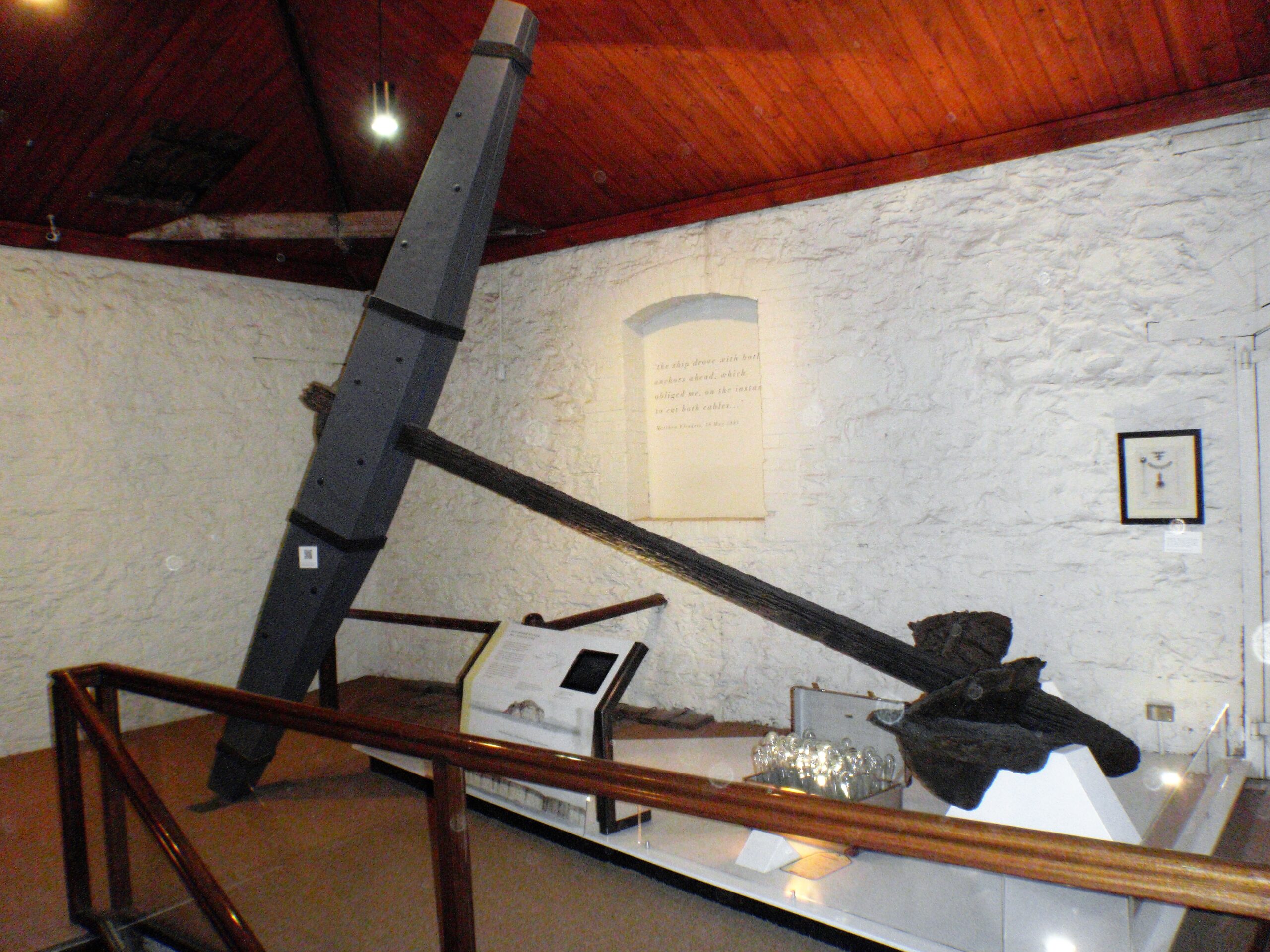
I can’t speak for the other injured parties in that serious MVA north of Port Wakefield but I can inform readers that one of the injured ,Terry Drew, who among other trauma lost a kneecap as a direct surgical necessity, managed to resume diving .I don’t know if he and spouse Helen were able to participate in the 2nd expedition ,but I can reassure readers that Terry went on to become one of S.A.’s more accomplished and very committed maritime archaeologists, in what was for the most part a small but devoted band of unpaid volunteers .I first met Terry more than a decade after that vehicle accident,perhaps even later, by which time he had participated in various similar adventures including at least one narrow escape when an IRB loaded with gear was flipped over by a huge wave close to shore near the wreck of the Loch Venachar (?spelling ) off the wild western end of Kangaroo Island .
I had the pleasure of participating in a one-off grant-funded expedition to better document the subtidal remains of another historically significant K.I wreck, the Fides ,on the North Coast .The two chief organisers were Bill Jeffrey(?Jeffrie?.. .apologies Bill, without checking my dive logs all I’m sure of where the spelling’s concerned is that there is no ‘s’ on the end of your family name ) and Terry Drew. Terry invited me as a photographer tasked with documenting some of the marine life on this shallow rocky shoreline wreck .We all enjoyed the experience ,although I didn’t find anything unusual or particularly photogenic on that wreck ,also my camera gear at the time was primitive by today’s standards (Terry,to supplement my 35 mm lens, even donated his rather worn out Nikonos 20 mm wide angle lens, which however was prone to fogging up because of a past slight egress of moisture into the interior via one of the two side mounted control knobs ).I got very mediocre pics of the wreck’s few remaining wooden beams and some had a wrasse or two included in the frame ,but visibility was limited because the wreck is in the littoral and shallow sub littoral, also its small and the 2 other divers were generating much raised sediment which, with the dives timed to minimize tidal current ,hung in the water column for ages!
But it’s on record somewhere in an article I wrote for MLSSA that at the completion of our Fides work we also dived the far more biodiverse wreck of the Portland Maru, well to the west of the Fides, and those 2 dives on the one perfect day remain the only time I have dived that large and slightly more intact wreck .But I digress…
In closing this lengthy comment I note that the only ‘useful under the grant fund’s criteria ‘ photo- of a leafy seadragon in nice clear water-I contributed was for a ‘Fides commemorative postcard ‘ ,and the photo was taken some years earlier at Western River or Snug Cove ,nowhere near the Fides!
The guys said we had to make do because my on site Fides shots just weren’t good enough.
Ouch, the truth hurts!
Thanks for these details, David. I knew some of the background re Terry, but I can’t answer your questions confidently. I didn’t realise that you had actually dived on the Fides at all. When was that?
Terry and Helen re-joined the second expedition after the anchors had been found, having recovered from their injuries.
There is much talk of Captain Cook’s Endeavour being found and discussion this may bring.
But closer to our Australian shores. This current news story has brought back deeply buried, but beautiful memories I would like to share with your readers, of a wonderful art teacher called Terry or Terrance Drew. Mr Drew to us. One of two at newly opened Underdale High School, South Australia. where I was fortunate to be a student (1967-1970), The school newspaper typist, printer and illustrator ‘Satire, committee’ and contributor the the school Almanac.
I can thank both for propelling me into the direction of an art career rather than just teaching art. If they were left wondering where I went. I had just turned 17, and found myself immediately employed by one of, later two major Adelaide and Australian retail department stores, in house, as their retail fashion illustrator 1971-1979 inclusive, and the start of a fabulous career in illustration for reproduction, covering most topics and subjects inclusive of plants, animals and fish species.
Mr Drew was well known and admired from the talk around the high school art room, to spend his between- term time at Esperance in Western Australia with a diving team. It was no secret that they and he had or were searching for Matthew Flinder’s HMS Investigator, some years later recovering a bell and two anchors.
I was so excited when this vision and project came to its end, and these three relics were retrieved. So sorry to hear of Drew’s injuries. I do not believe anything would stop him in his pursuit of his passion, to it’s end.
History exists. Knowing what happened, how, why, where and why is always of interest to all, as we are all part of it. And boats as maritime history helped create it.
Just a child, I arrived on a migrant boat. Many of us would have maritime stories to tell. The propeller having broken down at Fremantle after a 30 day sea voyage, an Orion Australian Air force plane taking over, refuelling at Adelaide Airport. The option was to stay.. No one knew where we were heading, the destination card, said Melbourne. Adelaide became home. I never saw Melbourne. The rest is history.
A thank you to my art teachers. And Terrance Drew who was always decorating the Art room and readily offered an opinion.. A great time, pop art, psychedelic paint, design, fashion, mini skirts. I am not surprised he became an accomplished maritime archaeologist and volunteer. One accomplishes most their dreams by volunteering. One cannot put a price on it.
One never knows exactly where influence comes from. But I can tell you, it is from those you meet and are around you in your life. Or to watch them pursue their passion. You may only join the dots, years later.
Please continue the story.
Claudia Marconi